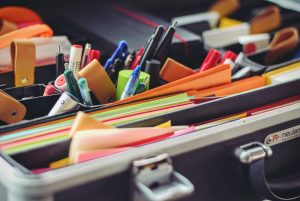Sitting this morning at the Community Room of the Oxford, MA Police Department, I was reminded of how much fun I had my first few years at Millipore running around with a photoionization detector (PID), an air pump or a dosimeter. We used these and other “fun toys” in the pursuit of Industrial Hygiene.
History
 As early as a couple of weeks into my summer internship in 2002, my at-the-time supervisor and now friend Cathy showed me the basics and let me loose with a bunch of instruments and a stack of blank report forms. She didn’t know she’d created a monster! Well, not so much, but definitely a steadfast fan. I fell in love with this most scientific aspect of the safety professional’s toolbox, and with good reason: it’s a fantastic way to drive your actions with real hard data.
As early as a couple of weeks into my summer internship in 2002, my at-the-time supervisor and now friend Cathy showed me the basics and let me loose with a bunch of instruments and a stack of blank report forms. She didn’t know she’d created a monster! Well, not so much, but definitely a steadfast fan. I fell in love with this most scientific aspect of the safety professional’s toolbox, and with good reason: it’s a fantastic way to drive your actions with real hard data.
The art and science of Industrial Hygiene dates back to Hippocrates and his study of medicine, drawing conclusions for specific ailments that resulted from certain occupations. It’s that kind of age I’m always eyeing for any discipline to study: something that humans have been curious about for thousands of years. At the time of my first steps into the field, I had little idea of its enormous history, but it was clear that I was helping obtain valuable data to drive important decisions.
Nuts and Bolts
Here’s how it works: we know a task entails the use of an airborne contaminant, but we don’t know if the worker is exposed to a dose that would harm them over time. To determine this, we must design an experiment, we call it an “exposure assessment” in which we’ll use instruments to measure directly or indirectly the concentration of the contaminant in the air immediately adjacent to the worker’s breathing zone. This is usually an air pump for chemical contaminants, a dosimeter for noise, a “badge” for radioactive materials, etc.
We’d then find one or more sample workers who’ll wear the equipment that will gather sample data for evaluation. This is done over the entire shift, usually up to 8 hours, since exposure limits are defined over the same period. That’s what we’re looking for: to compare the sampled air with the established exposure limit. If we’re above or near that limit, action will be taken to reduce the exposure. Real science at work!
As always, the poison is in the dose and it’s the key to determine how to proceed. And remember that even water can kill you in the right dose. Yes, water.
Impressions
 Between loading tubes in and out of an air pump (used to suction air from the worker’s breathing zone to analyze for a certain contaminant) or cleaning a PID lamp or two, I spent my time watching the work unfold and inquiring about this or that detail. Not only was this critical to a complete field report, but it helped me discover yet another aspect of this profession I’m passionate about: the need to communicate with your “subjects” not just to understand the obvious behaviors, but to dive deep into the attitudes.
Between loading tubes in and out of an air pump (used to suction air from the worker’s breathing zone to analyze for a certain contaminant) or cleaning a PID lamp or two, I spent my time watching the work unfold and inquiring about this or that detail. Not only was this critical to a complete field report, but it helped me discover yet another aspect of this profession I’m passionate about: the need to communicate with your “subjects” not just to understand the obvious behaviors, but to dive deep into the attitudes.
As a young(ish) intern, it was easy to strike up a comfortable conversation with anyone and glean key details that later helped us make even better improvements. I learned a lot about the motivations people have, or lack, to protect themselves at work, and how they view the safety profession in general. It was useful to get the inside track and it’s still useful today to get honest feedback rather than lip service.
The higher is the intake amount the more impacts can be felt in the lives of affected victims, but the consumption measure should be prescribed and should be taken under proper medical supervisions. icks.org purchase cialis online
Being a true nerd, once the data was gathered, either downloaded on the PC from the instrument or sample results back from the analytical lab, the time spent writing the report was pure bliss. I’d get to look up reference exposure limits, annotate observed tasks, attach photos, and enter the final results in that most distinguished box at the bottom of the form. With eager hands, I’d run to the printer to see the fruits of my labor become real and off I was to make sure it was all correct before we shared the results with the workers and filed them.
 Ok, I’ll admit the filing wasn’t exactly fun, but it was nice to feel the accomplishment of yet another assessment done as the file drawer thumped closed at the end of the day.
Ok, I’ll admit the filing wasn’t exactly fun, but it was nice to feel the accomplishment of yet another assessment done as the file drawer thumped closed at the end of the day.
Looking back at these specific assignments, I’m surprised at how much nostalgia comes up! I remember the “blue machine” room, where I’d work alongside bellow Latino employees and chat about our respective countries of origin as they’d show me how to do their job for my copious notes. Or the assembly area in “building L”, a mythical place just beyond the bike path, where you could feel the busy energy of a dedicated team. Not to mention the infamous “wet room”, where I learned the value of good nonslip safety shoes and quality testing. These were formative experiences that still nourish the professional I am today.
Looking Ahead
I’m still passionate about science and using data to drive improvements, and still in love with writing reports, arriving at conclusions and sharing results. And I look forward to many more chances to do so in the years to come.
Oh, and in case you’re wondering why the Mad Hatter and the Hulk? Both were presumably subject to occupational exposures to hazardous materials, mercury and radiation respectively. Both would’ve benefited from a robust Industrial Hygiene program to control those exposures, but I may be digressing…
Drop me a line or add your comment below to keep the conversation going!


Leave a Reply
You must be logged in to post a comment.